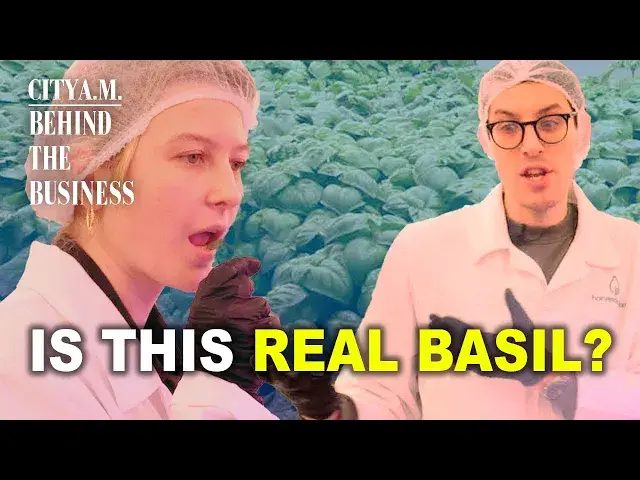This week’s ‘Behind the Business’ episode with City A.M.'s Jennifer Sieg dives into the depths of what’s going on inside Harvest London – the capital’s next up-and-coming vertical farm.
🌐 www.cityam.com
X(formerly Twitter): http://twitter.com/CityAM
Facebook: www.facebook.com/cityam
Instagram: www.instagram.com/city_am
LinkedIn: www.linkedin.com/company/cityam
Show More Show Less View Video Transcript
0:00
Oh yeah, I mean like, welcome to the farm
0:18
This is obviously quite a messy bit. We could have tidied it up a little bit more
0:23
Maybe we will tidy it up. This is air handling. This is climate control
0:30
And then in there is the grow room. Hello, Harry. Hello, Harry
0:35
And then we've got the sort of, this is the brains of the operation here
0:41
So this is the control panel and all of the technology inside looks after when we water our plants
0:48
when the lights go on, when the lights go off. The water treatments are keeping the water safe, but also providing the plants with all the nutrients they need
0:56
This is all controlled by a system that can be operated remotely
1:01
It gathers all of our data. We can do ysis on that data and improve how we grow
1:07
This is what's called the irrigation system. So this looks after the quality of our water
1:12
We've got nutrients and acid. And this also makes sure it's safe from a human point of view
1:20
We have some sterilization going on there. And then the rest of the building is, you know
1:25
washing stuff and desks and hygiene. Hygiene. Right, we will go in here
1:33
So this is vertical farm
1:51
And what we do in here is we grow crops all year all year round for our customers
1:57
So no matter the weather outside, we're providing the best quality, the freshest produce that you can find
2:04
certainly in London, and the plants are always happy, always growing as well as they can
2:09
and provided with everything they need. The amount of the season, no matter the weather. We've been operating this farm here
2:15
for about three years now. It the second farm that we built and we produce around six tons of fresh herbs whether that basil or salad or parsley or coriander or whatever else we got here at any one time for our customers
2:32
who are mainly restaurants and food service. So do you want to walk us through a little bit about
2:37
what the process is like? Sure. So when we first start off, these plants here are very young basal plants
2:47
So these were planted a few days ago. And they're planted into these cubes, which are organic and totally biodegradable, made of plant matter
2:56
And so the seeds are given a few days to germinate. And then they're put into the system under the lights
3:01
The lights are on for a lot more than you get sunshine outside
3:07
So the plants get a lot more light than they would outdoors, especially this time of year, of course
3:12
I mean they grow a lot faster. They stay here for about 10 days
3:16
and then we take them out and we do a process called transplanting, which is when we pick the plants out and we space them out to give them more room
3:23
It's kind of how you'd do out in your garden when you'd be, you know
3:27
you'd raise the seedlings inside and then you'd take them outside and spread them out
3:30
And do they turn into that then? Well, these are, this is a different plant. This is a mix of salads and these are just sewn onto
3:37
these are just a big sort of sheet of got a lot of water there, a big sheet of crops
3:42
So we've got sort of two, you know, broadly two different amounts of crops here. We've got a basil down here and salad
3:46
over here. And as we kind of move down the farm, you know, we end up with, you know, that's
3:54
a slightly older basil plant. They're kind of ready for transplanting now. And we've got
4:03
some slightly older salads down here. So this is this sort of salad mix. This is ready to go
4:08
out to a customer sometime in the next week by the looks of it. And we've got, this is a sort
4:14
of research and development area where we try. out new crop varieties we try out new lighting spectrums we also have computer vision cameras in
4:23
here measuring the height and the shape of the plants to give us lots of data to work with
4:27
and then after some time you know you end up with basil plants sort of that big wow
4:35
so you get a big a big old thing of basil you know you can try a bit if you want for oh little leaf of very fresh basil And that plant there is probably ready to be harvested by the looks of them
4:55
Without me checking, that looks like they're probably ready to be harvested tomorrow and be sent out to a customer
5:00
From when they're harvested, so in the morning the team will come in, take the crops out into our harvesting room, take them in, cut them down, box them up
5:09
Then they're given to bicycle couriers who cycle them all over London and they go from the farm to the kitchens in about four hours
5:17
So you don't really get much fresher than that. As a result, the plants taste really good
5:23
There's no waste. So everything turns up perfect. And they last ages as well
5:27
So the customers end up throwing less away. It actually means they end up buying a bit less in the longer because they're throwing less away
5:34
But we see that as a good thing. It's a good problem to have. and we've got a variety of things here
5:40
We've grown over 200 different types of crops in this farm and so we can be very flexible on what we grow and who we grow it for
6:02
When we started the business, it was just two of us, It was really, really hands-on
6:08
I mean, it always is hands-on here, I think, by nature of what we do. But I was kind of doing loads and loads and loads of different jobs
6:15
I was growing all the plants, harvesting them, packaging them up, putting them in my car
6:19
driving them to customers, selling them out the boot of my car into kitchens. As the team has grown, as the company has grown, as the farmers have grown
6:27
we've brought more people on with various areas of expertise. I think when we started the business, everyone was doing a little bit of everything
6:34
As the business has grown, people have become more specialised. The people we hire, their skill sets are people who have got lots of experience in certain areas that we need as we grow
6:47
My job as co-founder here, but also as Chief Scientific Officer, in charge of the growing operations and the production
6:56
I split my time between nowadays, between a lot more business activities
7:00
So whether that's expansion into a new site or whether that's, you know providing the wider business with information they need around how the plants grow or different crops we working on but then also still coming in here and making sure that I around to be able to fix a pump if it breaks or stop a leak happening
7:17
Because I think with the nature of what we do, whilst it is, it's the middle ground between sort of manufacturing and agriculture
7:26
So there's still plants at the end of the day so they don't always behave themselves, although we do a lot to make sure they behave themselves as much as they can
7:33
but also there's just a lot of pipes and a lot of water and a lot of electricity
7:37
so with that comes technical issues that need fixing and they need fixing them at the time of
7:43
day or the day of the week really as the business has grown we've become stabilised a lot more
7:47
I mean I remember when we first built this place we'd flood this room pretty regularly all the
7:51
water from the main tank could end up on the floor because we'd make mistakes or because
7:55
a pipe wasn't sealed properly or whatever it was but as time's gone on this is a very stable place now
7:59
So it just works every day, 365 days a year. This is what we grow in, so these trays we reuse, we recycle them, we wash them every time they're used
8:19
We fill them with our growing medium and then they go into the automatic seating machine
8:24
So the tray goes in here like this when it's plugged in
8:29
seeds go in here this bar bends down sucks up some seeds spits them down the tube moves the tray
8:38
sucks up some seeds spits them down the tube moves the tray and so on and so on and so on until the
8:43
tray is pushed out the other end and it's full of seeds then we water it wrap it up put it into
8:50
germinate i used to do all the seeding by hand in our old farm this saves hours and hours and
8:54
hours it's a bit of a collector's item now the guys that make it have all retired so they don't make these any
8:59
But things like this are used in conventional agriculture all across the world, in glass houses
9:05
open field agriculture. They sometimes come in different formats, sometimes they have big spinning drums, fancy ones
9:11
have got conveyor belts that run underneath. But this is the sort of lowest level of automation you can kind of get in a farm like
9:17
this apart from obviously all of the stuff that keeps our environment and air and water
9:23
at the correct level
#Gardening
#Crops & Seed
#Farms & Ranches


